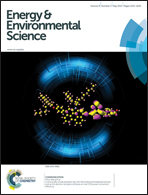Atomic scale enhancement of metal–support interactions between Pt and ZrC for highly stable electrocatalysts†
Abstract
To further obtain high catalytic activity and durability of Pt catalysts for oxygen reduction reaction (ORR), we synthesized a robust Pt-on-ZrC nanocomposite catalyst by taking advantage of atomic layer deposition (ALD) to improve the strong metal–support interactions at the atomic level. X-ray absorption near edge structures (XANES) results show that ALD-Pt/ZrC catalysts show noticeable change in the electronic structure of Pt due to strong interactions with the ZrC support. Using electrochemical cycling to test durability, we found the ALD-Pt/ZrC nanocomposites to be roughly 5-fold and 3-fold more stable than commercial Pt/C and CW-Pt/ZrC (synthesized by a conventional chemical reduction method), respectively. The ALD-Pt/ZrC nanocomposite showed a mass activity of 0.122 A mgPt−1 at 0.9 V (vs. RHE); much higher than those for Pt/C and CW-Pt/ZrC catalysts (0.074 and 0.041 A mgPt−1, respectively). After durability test, our novel catalyst also exhibited ORR activity 9 times greater than Pt/C. This approach, using ALD to grow the Pt catalyst directly, resulting in strong interactions, will aid the design of new active and stable catalysts for ORR or other chemical reactions.


 Please wait while we load your content...
Please wait while we load your content...